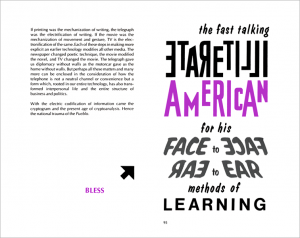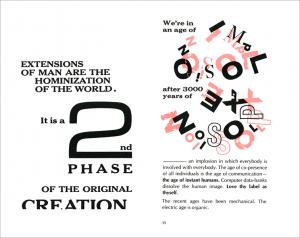This post is part of an ongoing series featuring items from the newly acquired Santo Domingo collection.
 Counterblast by Marshall McLuhan is a unique book with insights into human interaction with new technologies and media. A Canadian communication theory philosopher, McLuhan investigates the way new media has changed the world, with an interesting focus on television and mass visual media. This printing was designed by Harley Parker, a Canadian artist and designer, who often worked with McLuhan in the area of art and technology. Full of mind-bending illustrations, Counterblast is as interesting for the content as the unique images that enhance it.
Counterblast by Marshall McLuhan is a unique book with insights into human interaction with new technologies and media. A Canadian communication theory philosopher, McLuhan investigates the way new media has changed the world, with an interesting focus on television and mass visual media. This printing was designed by Harley Parker, a Canadian artist and designer, who often worked with McLuhan in the area of art and technology. Full of mind-bending illustrations, Counterblast is as interesting for the content as the unique images that enhance it. 
McLuhan’s philosophy, that communication technology influences the organization of society, became incredibly popular during his life time, and his most famous work Understanding media (1964) caused a sensation in the intellectual world. Counterblast, originally written in a shorter form in 1954, discusses the changes that communication technology causes, that are later addressed in Understanding media. One of the many interesting quotes in Counterblast explicates the impact of television: “TV children have lived several lifetimes by the time they enter grade 1, just as they have travelled farther by the age of 7 than their grandparents ever travelled. The TV adult returns to grade school in order to make possible several new careers for himself. Acceleration of information movement can have, as one of its consequences, a multiplicity of jobs for everybody.”
 McLuhan is well represented in the Harvard Libraries and many of his books can be found in the catalog. The Santo Domingo Collection copy of Counterblast [by] Marshall McLuhan, designed by Harley Parker is inscribed by McLuhan to his friend D’Arcy Hayman, an artist and writer also interested in communication technology.
McLuhan is well represented in the Harvard Libraries and many of his books can be found in the catalog. The Santo Domingo Collection copy of Counterblast [by] Marshall McLuhan, designed by Harley Parker is inscribed by McLuhan to his friend D’Arcy Hayman, an artist and writer also interested in communication technology.
Thanks to Emma Clement, Santo Domingo Library Assistant, for contributing this post.
